Bathing in gentle bugs at the top of the world
During an excursion to a high-altitude meadow, I found myself admiring the small things as well as the big. Plus, some thoughts on beavers and lodgepoles in Yosemite National Park's Tuolumne Meadows.

I was chasing a tree when the bug incident transpired.
It was a little past dawn, which takes a while to unfold in the high country of Yosemite, a stunning collection of glaciated canyons, meadows and crags. Sunrise was pouring golden light over the 13,000-foot-tall peaks surrounding me. At first, I’d focused on the immense granite peaks and the river’s sparkling clarity. Then, I obsessed over the trees, wondering why they were all lodgepole pines. No aspen. Few willow.
From a distance, a massive red tree trunk drew me from my campsite into the meadow. It was no lodgepole, which typically sport dull grey trunks. I needed to identify this red giant. Could it be an incense cedar or a Jeffrey pine? Both unlikely at this altitude.
The further I walked, the further away the large tree stood. Then, it was gone. The stealthy thing eluded me by disappearing into a crowd of lodgepoles across the river. I lost track of it. Maybe the red bark was an illusion caused by the rising sun.
A few ripples and splashes told me small fish swam in the river. There must be bugs for them to eat.
The main backpackers’ trail traversed the river’s other side. Out here, there was no path. I walked knee deep in a hundred varieties of flowers and grasses, the dew dampening my shins.
Tiny flowers drew my head down. They were packed so tightly into the vast field. Tunnels wove in and out under them, making the ground uneven and swelling with mounds. Small white, purple and yellow flowers, no bigger than a nickle, swayed lightly between grasses of all shades of green. Buckwheat, aster, cinquefoil, goldenrod, sunflowers and penstemon. Teeny yellow and brown mountain pretty face.
I sat down.
I’d already noticed hundreds of fritillary butterflies1 on our four-mile hike into the backcountry. They were the meadow’s princesses. Showy, bold and everywhere.
Soon, a soft tickle crawled up my leg. A miniature ant. Much smaller than a house ant. Then, right next to me, a white spider crept among the puffed seeds at the tip of a grass stem. An itty bitty light green grasshopper, translucent, hopped onto my shirt. An orange beetle stepped lightly onto my hand. A leafhopper dangled on a shoot of wildflower leaf before my eyes, its bright fresh greenness nearly blending in. A dusty moth flew by. Ladybugs, big ants, tiny flies and lacewings. Funny that I hadn’t noticed them until now.


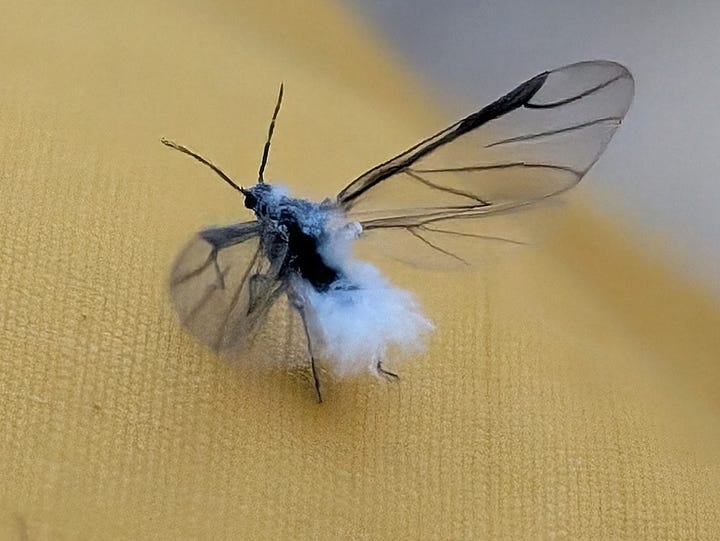
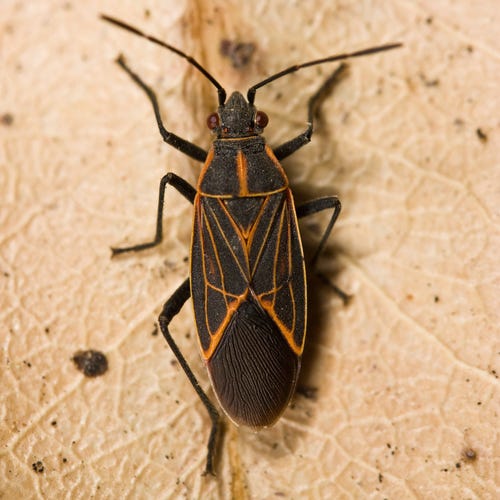
I’m no bug person. But in this moment, each bug, so new and unique, surprised me with its smallness and perfection. Delicate legs carried each on its meditative journey forward.
A bug never walks with ambiguity. It’s always going somewhere. Slowly, but with purpose.
The more I studied my surroundings, the more bugs appeared. The meadow teemed with them. Within a few minutes, bugs were crawling all over me. Lightly, gracefully, silently. I’d sat right in their path, after all, and they had things to do, destinations to reach. They traversed my body like it was any other path in their universe.
You’d think I might jump up and shout. But instead, I breathed in deep and let them caress me. These weren’t biting bugs. They were gentle, high-country meadow bugs. They’d been here this whole time, as I was looking at bigger things. As I was busy chasing that elusive red tree.
I knew that if I fell back onto the cool earth and closed my eyes, the flowers and the grasses and the bugs would softly help me become the meadow, too.
Perhaps these critters didn’t repulse me because, just the night before, I’d been staring into the mouth of the universe. This tends to put a person into a transcendental state of mind.
At our 9,000-foot perch, my family and I had spread ourselves along a huge slab of granite to gaze at the stars. Swallowed up in a wilderness without light pollution, dark night filled every corner of our vision.
Some quotes from my 11-year-old daughter:
“Oh, that’s the Milky Way.”
“Does the universe end?”
“Can we do this more often?”
The first shooting star flew across the sky within minutes. The second came a few seconds later. By the end of the night, dozens had lit up our view.
That night, I thought of a Hindu parable where baby Krishna is accused of eating dirt. His foster mother, Yashoda, tells him to open his mouth. When he does, she looks in and gasps. There, she sees the entire universe.
I suppose this parable can be interpreted in various ways. Perhaps, for some, it’s another example of Krishna’s divinity. For me, it’s a reminder that the universe is always much closer than we believe. It’s not just up there, far away, in the stars. It’s in the bugs and their million acts of busy gentleness. It’s deep in the meadow, where burrowing creatures weave thousands of tunnels that help the wildflower seeds regenerate. It’s in the bats who fly silently at dusk, the fish who leap, and the soil with its constellations of mycelium that feed everything above.

Tuolumne Meadows is shrinking
Tuolumne Meadows isn’t as wet as it used to be. Lodgepole pines are encroaching on all sides, creating more of a forest than a marsh. The National Park Service has been removing lodgepoles from Tuolumne every couple of decades for the past 100 years to “preserve views.”
The meadows are drying out, but, in my observation, it isn’t for lack of water. A small year-round glacier still crouches on the flank of Mount Lyell at 13,000 feet. The river runs all summer.
Turns out, this seemingly pristine place has seen a lot of environmental manipulation over the years. Roads, intensive grazing and loss of willow have changed the shape and flow of the Tuolumne River. Bridges and drainage canals channelized the river and lowered water tables.
In addition, the encroaching lodgepole pines drink a lot of water. Studies have shown that when they are removed, meadows stay wetter, resulting in higher groundwater, increased soil moisture and improvements in plant biodiversity. However, simply removing lodgepoles doesn’t permanently solve the problem. As long as conditions are right, and not too wet, they come right back. Warmer, drier weather brought by climate change will make alpine meadows even more hospitable to lodgepole pines.
And finally, speaking of bugs: The park service historically sprayed pesticide on lodgepole needle miner moth outbreaks to preserve lodgepole pines elsewhere in the park, while simultaneously chopping them out of Tuolumne. This likely led to an overgrowth of lodgepole in general (fire is not a part of this high-altitude ecosystem). Now, the park service allows the moths to do their thing. The lodgepole needle miner is an insect endemic to Yosemite and now inhabits 40,000 acres of the park.
What about beavers in Yosemite’s high country?
Ever since reading “Eager,” by Ben Goldfarb, I view landscapes differently. I’m always thinking about beavers and what they’d be doing if we hadn’t eliminated them from our rivers 170 years ago. So I have to wonder, could beavers help save Tuolumne Meadows?
California’s Department of Fish & Wildlife changed its anti-beaver stance in 2023 and now sees them as a vital keystone species that could help restore the state’s mountain meadows. The agency has begun translocating beavers from places where they’ve grown a nuisance to meadows where they’re direly needed.
It took until 2023 for this shift to occur because much debate has transpired about whether beavers previously occupied the American West. Fur trappers arrived before naturalists and extirpated beavers from the landscape. But as “Eager” describes, Native American place names and beaver bones at archaeological sites prove they were once here.
“We’ve been through numerous droughts over the years. Going through these droughts we were wondering how we can conserve, save water, get water here on our lands,” said Kenneth McDarment, a Tule River Tribe member and past tribal councilman. “The answer was in our pictographs.”
Estimated to be between 500 and 1,000 years old, beaver pictographs can be seen at Painted Rock next to the South Fork Tule River on the 55,356-acre reservation. Tribal elders recall beavers being present in the high elevation meadows when they were young, but prior to this release, beavers have not been present on the reservation for decades.
Beavers have returned to Yosemite Valley and other lower elevation areas of the park, but not to the high country. To reach Tuolumne by following water, a beaver faces the steepest waterfalls in the world. The Grand Canyon of the Tuolumne gains 6,000 feet of elevation over 30 miles. Snowmelt in Yosemite is a massive rushing flood that would likely destroy many beaver structures.
But when my family and I hiked to the top of Potter Point (10,732 feet or 3,271 meters), I looked down at a very square marsh in Lyell Canyon and wondered whether it was an indication of previous beaver habitation. Goldfarb describes that lines of vegetation or earthen structures running perpendicular to streams could be evidence of previous beaver activity.
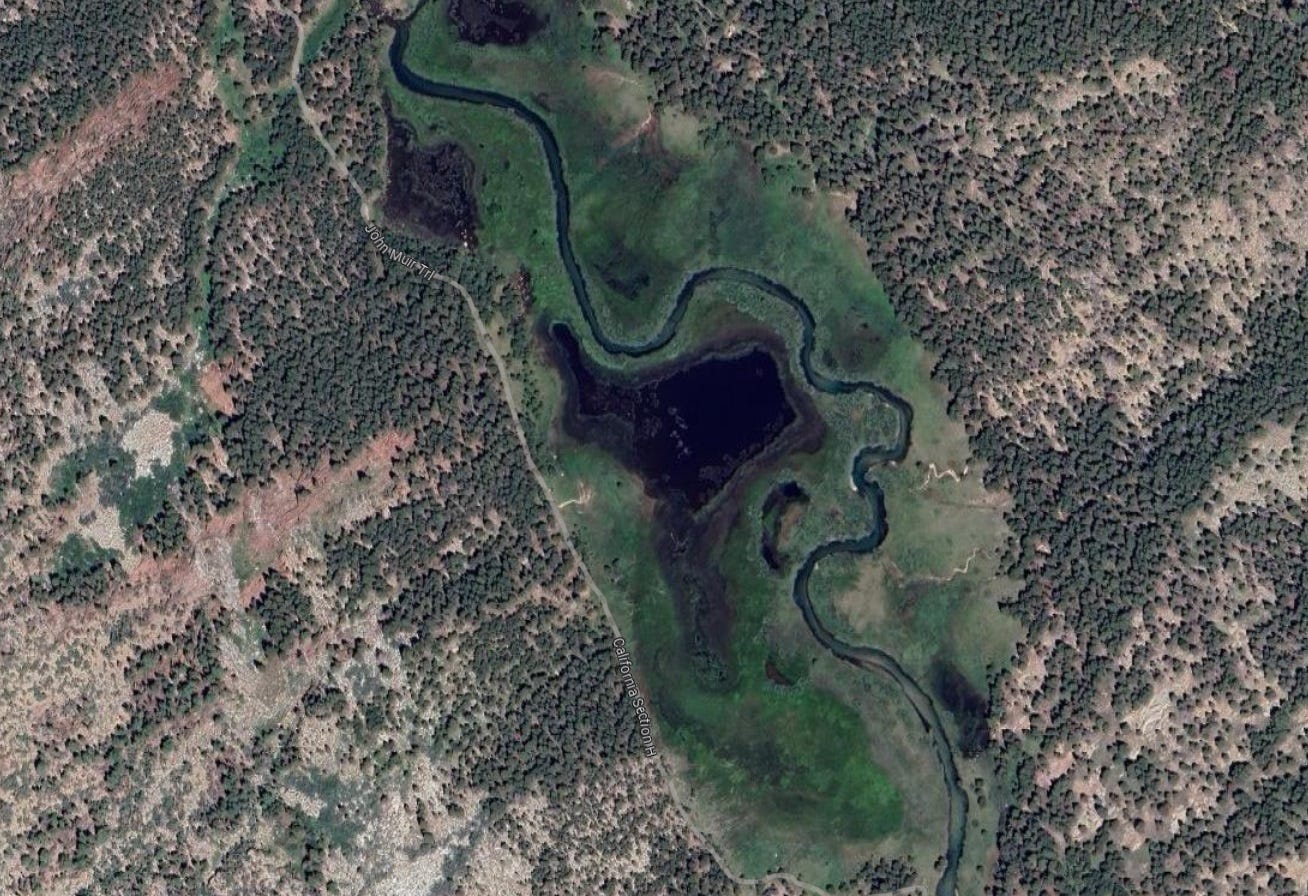
Beavers are being reintroduced across the West to help with drought, flooding and wildfire prevention. Wetlands improve water quality and store carbon. Susie Creek, Nevada, is a famous example of how beavers can resoak an ecosystem. Could beavers help Tuolumne Meadows?
I contacted the National Park Service with this question but haven’t heard back. If you have any knowledge or thoughts in this area, please share a comment.
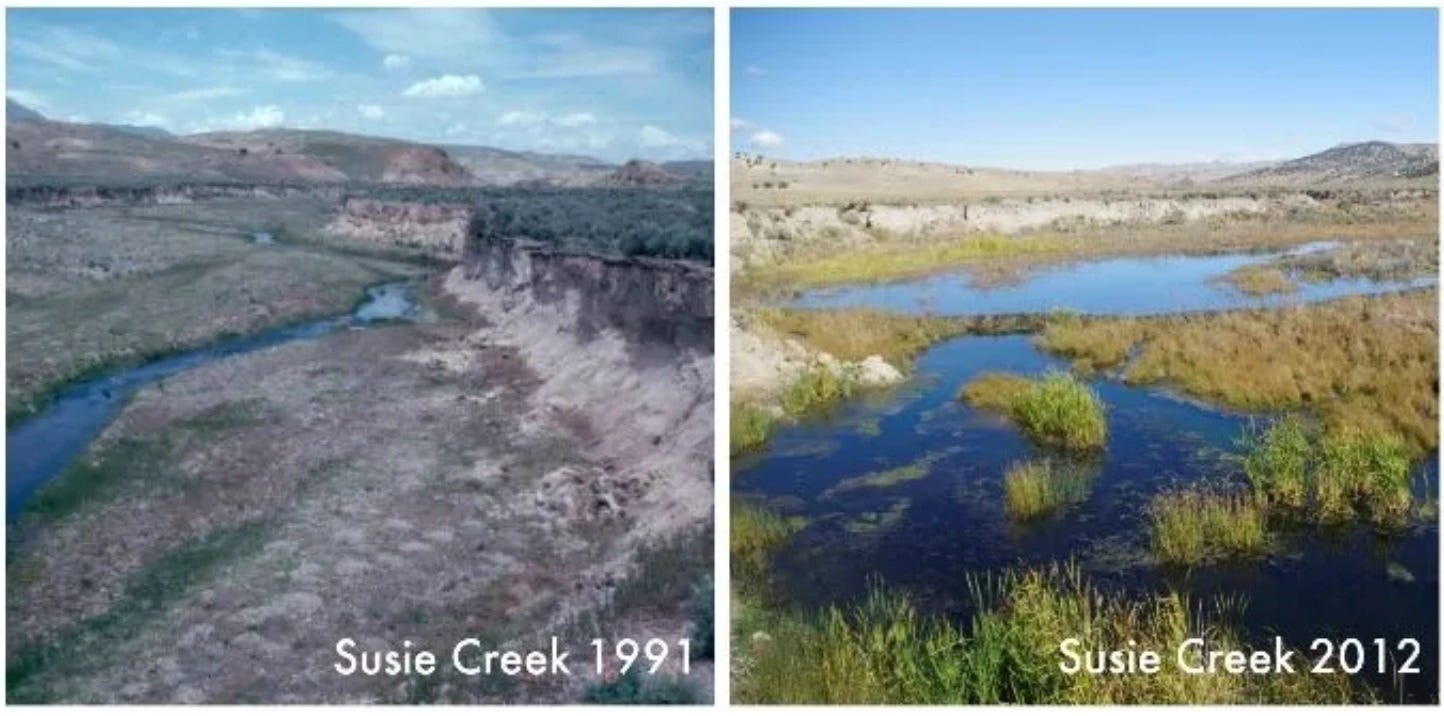
Thanks for joining me on this brief foray into nature writing, where I left you with more questions than answers. You’ll notice the bug pictures are not mine.2 I often don’t take pictures when I’m deep in nature. Pulling out a phone distracts me from wilderness moments, when I prefer just being. This habit irritates my family, who prefer a log of everything we do. My phone’s battery went dead as soon as we arrived in the backcountry. Good. I might have missed something important if it hadn’t.
Hopeful headlines
This month’s issue of “Homebound Nature News” by
highlights efforts across Europe to restore bison, known in several languages as wisent, her namesake.One initial finding of interest is that a 20-mile square grassland in Romania sequestered an additional 54,000 tons of carbon annually due to the action of its restored, 170-member herd of bison.
Conservation is carbon sequestration!
By patrolling the beach, unpaid, for seven years, they have protected hundreds of adult sea turtles and saved thousands of hatchlings from predators and human disturbance.
First sighting of salmon in 100 years marks key milestone for California dam removal (This relates to the story I wrote last month on how the Yurok Tribe are restoring every part of their world, including rivers, redwoods, prairies and condors.)
“This fish marks the beginning of the recovery for the fishes of the Klamath,” said Damon Goodman, a fish biologist and regional director at California Trout. “This is testament to the success of dam removal and marks a new beginning for the Klamath River.”
London’s Once-Tidy Green Spaces Are Going Wild, On Purpose
The Royal Parks, the charity that runs Regent’s Park and seven more of London’s most famous public parks, along with Brompton Cemetery and Victoria Tower Gardens, has been “rewilding” the 5,000 acres it manages, as a response to the global climate and biodiversity emergency.
Wastewater bacteria can break down plastic for food
First, they chew the plastic into small pieces, called nanoplastics. Then, they secrete a specialized enzyme that breaks down the plastic even further. Finally, the bacteria use a ring of carbon atoms from the plastic as a food source, the researchers found.
Wildlife workers throwing salmon carcasses into wooded areas to preserve local ecosystems
Like the Easter bunny hiding Easter eggs, Fischer will go to a total 12 specific locations along the Santiam River and leave hundreds of salmon carcasses for the native wildlife to eat. Fischer said this gives the ecosystems the nutrients it needs to continue thriving. Since the 1980’s, the ODFW and fish hatcheries have worked to keep this program moving.
🐟🦦🐻🦅
About Earth Hope:
Earth Hope is a solutions-based journalism project that highlights environmental success stories from around the globe, because hope is the foundation of progress. Consuming bad news is important, but we should also remind ourselves frequently that progress happens every day. Read more about this project and what inspired it.
About me:
I’m Amanda Royal, a former newspaper reporter who covered wildfires, invasive species, water quality, wildlife and other environmental topics in California and Nevada (while writing under my maiden name and byline Amanda Fehd). The pseudonym “Earth” was a bit accidental. It grew on me quickly, so I thought I’d keep it for a while. I’m new to Substack as of late July 2024. Thanks for the wonderful reception!
Signing off with my latest on Notes:
There are at least 16 subspecies of fritillaries in Yosemite National Park, according to the iNaturalist page on Yosemite butterflies.





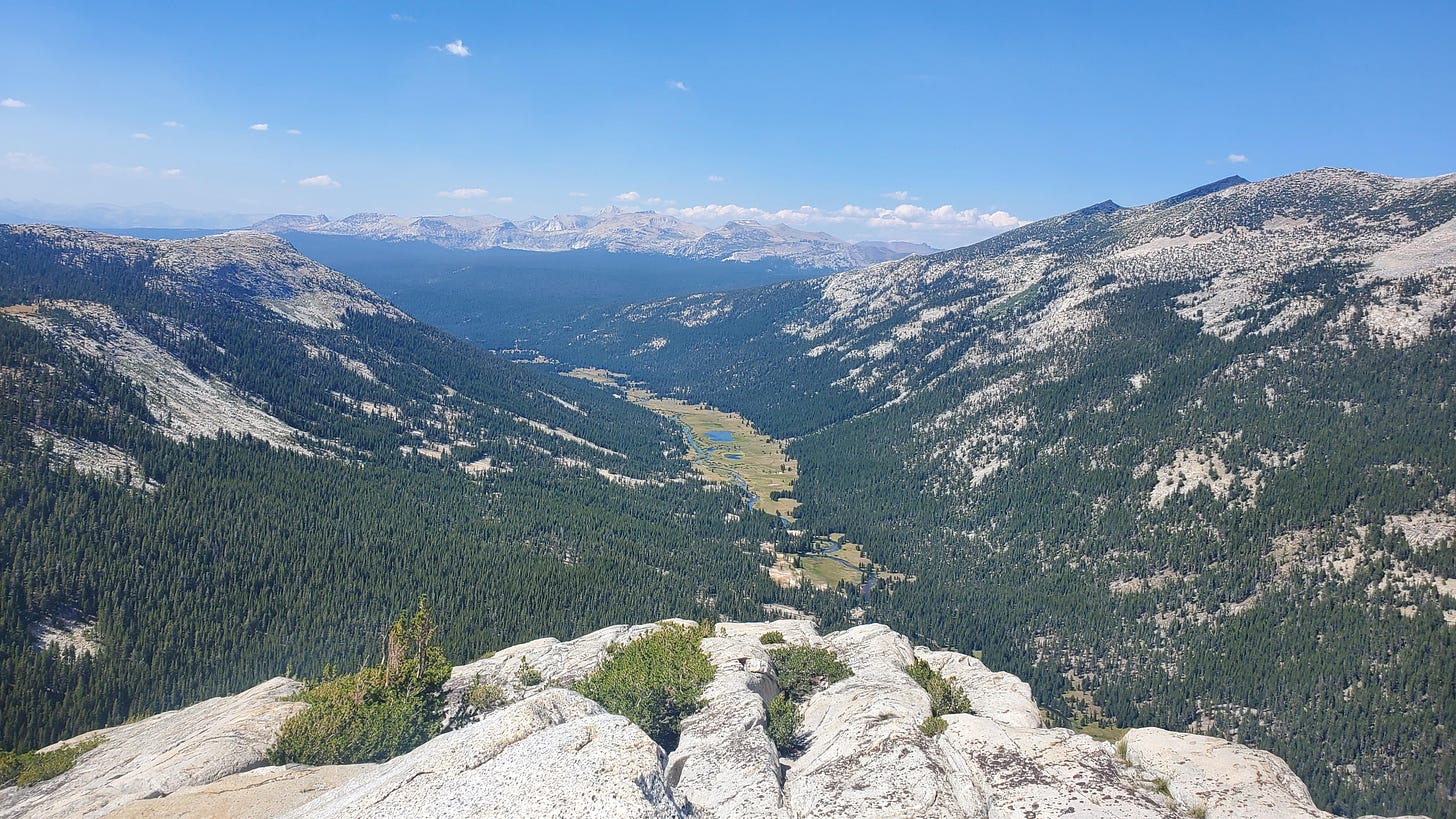

What a lovely selection of bugs from your walk and who could resist a flower called Mountain Pretty Face?
Beavers have done wonderful things in some of the areas of the UK where they've been reintroduced.
This: Tiny flowers drew my head down. They were packed so tightly into the vast field. Tunnels wove in and out under them, making the ground uneven and swelling with mounds. Small white, purple and yellow flowers, no bigger than a nickle, swayed lightly between grasses of all shades of green. Buckwheat, aster, cinquefoil, goldenrod, sunflowers and penstemon. Teenee yellow and brown mountain pretty face.
Gorgeous writing, Amanda. You bring hope clad in splendid attire, adorned with brainy scientific jewels.